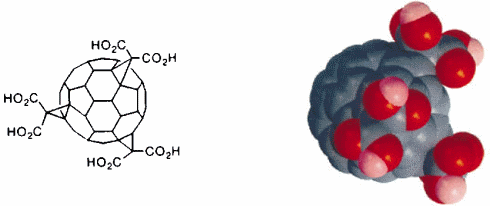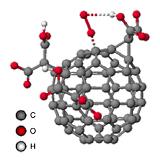|
C3, the 'successor' to C60 (note the quotes, dear readers)
Yesterday we wrote about a spectacular animal study in which C60 molecules dissolved in olive oil almost doubled the lifespan of rats. Today we are talking about another animal study, in which the C60-related C3 also turned out to have interesting anti-aging properties. Although the effect of C3 is less sensational than that of C60, this study clarifies approximately how molecules like C60 could work.

C3
In the early 1990s, chemists developed the molecule C3 by attaching groups to the C60 molecule. Those groups would make the molecule water soluble, making it more bioavailable. It was not known at the time that you can also make C60 molecules more bioavailable by dissolving them in oil.
C3, as shown in 1997 Washington University School of Medicine in vitro studies, [Proc Natl Acad Sci U S A. 1997 Aug 19;94(17):9434-9.] makes brain cells more resistant to oxygen deprivation and starvation. The researchers also found evidence that C3 protects brain cells from plaques.
Study
In 2008, researchers from the same group published an animal study in which they gave one-year-old mice - say, middle-aged mice - a dose of C3 every day through their drinking water. If the mice had been adult humans, they would have received 60-80 milligrams of C3 daily.
Results
The mice in the experimental group lived an average of 11 percent longer than the mice in the control group.

The researchers gave the mice dihydroethidium, and then looked in the brains of the animals to see how much oxidized dihydroethidium they could find. As the brains age they produce less antioxidant enzymes such as SOD and more free radicals.
The more oxidized dihydroethidium the researchers found in the brain cells, the more free radicals these cells produce, the fewer antioxidant enzymes the cells manufacture, and the further the aging progress had progressed.
The figure above shows that C3 makes the brain cells of old mice function like the cells of younger animals. Based on previous studies, the researchers suspect that C3 is mainly active in the mitochondria of the cells.
The researchers tested the memory functions of the older mice, and found that C3 brought the animals' ability to absorb and use new information back to a level that you would expect from younger animals.
Conclusion
"An administered antioxidant with mitochondrial activity and nervous system penetration not only increases lifespan, but rescues age-related cognitive impairment in mammals", write the researchers. "SOD mimetics with such characteristics may provide unique complements to genetic strategies to study the contribution of oxidative processes to nervous system aging."
The more we learn about them, the more interesting we find these types of molecules. Although we can hardly imagine that those things have no side effects.
More coming soon.
Source:
Neurobiol Aging. 2008 Jan;29(1):117-28.
More:
Can C60 double your lifespan? 09.08.2020
Archives:
Longevity
|







